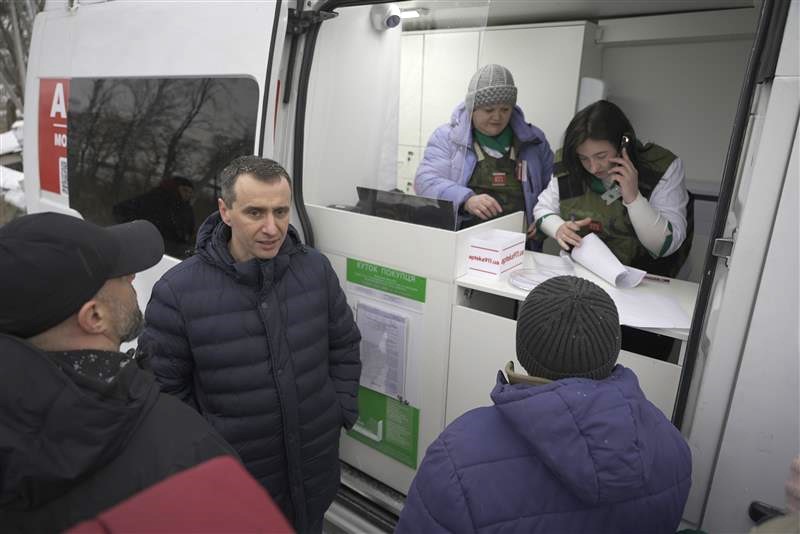Opinion: Four Ways Ukraine’s Health Care System Has Weathered the War
Opinion: Four Ways Ukraine’s Health Care System Has Weathered the War

In recent years, multiple successive blows have hit Ukraine — the global pandemic, a full-scale invasion, and more than two years of war. You might expect that health care in a country faced with such adversity would be crumbling.
But the reality may surprise you: Ukraine’s health system has proved extraordinarily resilient. Medicines in vast parts of the country are easier to access and afford. People continue to be able to get tested for HIV and receive preventive treatment. And despite the challenges, the government of Ukraine, GOU, continues to take steps toward its long-term goal of a European-integrated health system.
These successes are the result of careful investments applied with a whole-system approach. Other countries can learn from this example. Here are some things that Ukraine has been able to achieve.
Getting medicines where they need to go
One of the most critical elements of any health system is the process by which quality medicines and other medical products get to the people who need them — known as the supply chain.
Management Sciences for Health (MSH) and the GOU have been working together for years to transform Ukraine’s health supply chain. In the old model, central government programs procured health commodities, often of unknown quality, and transported them from national warehouses to regional distribution centers, where the supply chain ended. The warehouses lacked a systematic way to deliver these products to public health facilities and their vehicles lacked the capability to keep products cold.

In 2019, the successful pilot of a partnership with a private sector logistics company for last-mile distribution led to a rapid scale-up across other regions. Originally intended for HIV and tuberculosis medications, Ukraine expanded these partnerships to move other health products as well. Thanks to digitalized processes and a nimble fleet of vehicles, the system was adaptable when the full-scale Russian invasion began in 2022.
As the war rages on, Ukraine has been able to pivot to address the acute shortages of medicines and set up its own humanitarian medical supply chain that distributes massive volumes of donated medicines and medical supplies across the country. Further, the country has looked to improve the regulatory environment so that those medicines that are delivered are evidence-based and have been quality-assured.
Once medical supplies complete their journey along the supply chain and reach the community, they still need to be distributed to patients — including in remote areas and war-affected regions, where there is a shortage of pharmacies. To address this critical need, we spearheaded the necessary legal and policy reforms to authorize the creation of mobile pharmacy units, which are now bringing medicines to patients who had little to no access.
Making sure people can afford their medicines
As well as being accessible, medicines must be affordable. We have been working since 2017 to provide Ukrainians with access to low-cost medicines for chronic conditions through the creation of the Affordable Medicines Program, or AMP.
Building on market dynamics, digital solutions, and legislative reforms, AMP offers patients and providers a simple way to find quality medicines at the right price. Over time, Ukraine has expanded the program to include more medicines, medical devices, and participating pharmacies.
According to the National Health Service of Ukraine, the program has supported nearly 5 million people with chronic conditions, allowing them to afford lifesaving medications. In light of the full-scale invasion and its effects on Ukrainians, the program has pivoted to meet population needs by expanding to cover medications for mental health.
Staying vigilant against HIV
System improvements that began before the war have helped Ukraine keep tabs on the HIV epidemic. According to Ukraine’s Center for Public Health, in 2023, there was an increase in HIV testing in Western and Central Ukraine, mostly due to the availability of rapid HIV tests; the number of people receiving pre-exposure prophylaxis was on the rise in early 2023; as was the number of patients receiving a multimonth supply of antiretroviral therapy, or ART. These numbers have not decreased despite challenges such as patient migration — both domestic and international — destruction of health facilities, and lack of staff and funding.
During the war, Ukraine made rapid adjustments to its HIV and TB services. Under guidelines issued during the first week of the invasion, HIV patients could receive ART at their temporary locations. The GOU reallocated funding to support high-migration regions, and expanded eligibility for HIV care programs. TB services were maintained through the redistribution of supplies and humanitarian aid to the centers most affected by the war.
For Ukrainians abroad, the GOU developed a standardized protocol with the World Health Organization and partners to facilitate medical data exchange, ensuring continued HIV treatment. TB patients received support in connecting with clinics abroad, with translated medical certificates provided.
Keeping long-term goals in mind
From the early days of the invasion, we have been drafting recovery plans that envision a more transparent, people-centered health system. This has been a complex set of challenges for Ukraine, especially as the country continues to implement reforms aligned with European standards to advance its European integration goals amidst an ongoing full-scale war.
In July, representatives from Ukraine’s Ministry of Health met with U.S. health officials to inform efforts to streamline functions currently performed by multiple agencies into one new regulatory body like the U.S. Food and Drug Administration. This new, more efficient regulatory body will be an important step on Ukraine’s journey to integrate with Europe’s standards.
As we look to a future where Ukraine aligns with the highest global health standards, and aims to be a committed member of the European community, we are keen to share the lessons we are learning to inspire other countries to invest in strong health systems even in times of war.